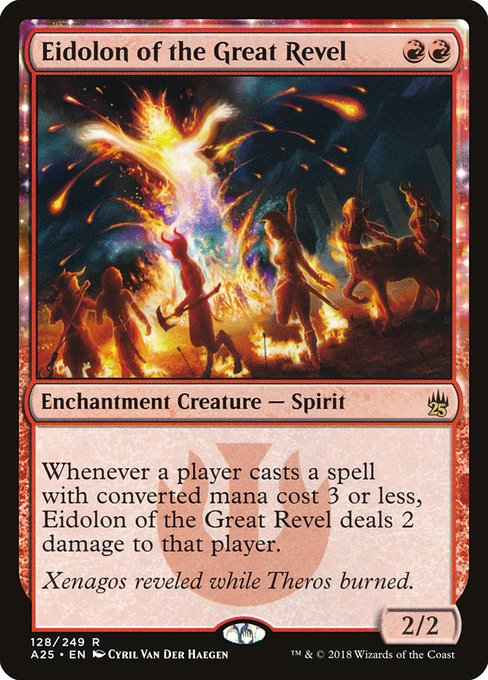
Image courtesy of Scryfall.com
Parody, Power, and Community: Eidolon in MTG Culture
Magic: The Gathering fandom thrives on a delicate dance between competitive necessity and communal mischief. We build our decks to outplay the person across the table, yes, but we also build shared jokes, memes, and nods to the game’s lore that knit us into a wider tribe. Parody is a spark that keeps the game lively between friday night leagues and midnight livestreams 🧙♂️. Eidolon of the Great Revel—a bright red beacon from Masters 25—illustrates how a single card can become a cultural mirror: it looks at how we play, what we value, and how we love to poke fun at the stubborn axioms of mana curves and “priority.” The card’s very being—a fiery 2/2 Spirit with a simple but punishing trigger—invites both tactical play and playful commentary about how cheap spells shape the tempo of the game 🔥.
What Eidolon of the Great Revel actually does
Eidolon of the Great Revel is a red enchantment creature from Masters 25, with a mana cost of {R}{R} and a modest 2/2 body. Its true bite isn’t in its power on the battlefield, but in its text: “Whenever a player casts a spell with mana value 3 or less, this creature deals 2 damage to that player.” In practice, that means two things. First, red tempo strategies can leverage an early aggression edge, punishing both players for cheap spellcasting and forcing a delicate calculus about what to cast and when. Second, the ability creates a dangerous, almost mischievous dynamic at the table—your opponents must weigh every spark, daze, or shock, knowing Eidolon stands ready to flash-fire back when low-cost spells land. The flavor text—“Xenagos reveled while Theros burned.”—reminds us that red’s appetite for risk and revelry is baked into the mythos, a wink to charismatically reckless energy that fans adore 🎭.
Parody as identity: memes, art, and the social glue
Parody in MTG isn’t just about jokes; it’s a social instrument that helps players connect across ages, formats, and playstyles. Eidolon’s symmetrical ability—damage to the spell caster whenever a small spell is cast—becomes a favorite subject for memes about “tiny spells, big consequences.” Fans riff on the idea that even a two-mana cantrip can backfire in spectacular fashion, flipping the table-notion of “easy wins” into a shared comedy of errors. The card’s red-on-red chaos also lends itself to fan art and cosplay that celebrate the revelry of Theros’ mythic landscape, while nodding to Xenagos and his mythic ambition. The result isn’t just nostalgia; it’s a way to signal belonging—an inside joke that welcomes new players into a community that knows how to laugh at its own aggressions 🧙♂️💥.
And there’s more under the hood. Eidolon’s design, with a straightforward mana cost and a straightforward trigger, embodies a teaching moment about red’s archetypal strengths: acceleration, aggression, and inevitability when the game pivots on casting-laden turns. In casual circles, this translates to a ritual of “counting cards, counting breaths,” as players parse whether the next spell is worth the life in the bank and how much trouble Eidolon will cause if it sticks around. The humor then becomes a bridge: a way to discuss timing theory, risk assessment, and even the ethics of “burn” strategies without losing the shared joy of playing together 🔥⚔️.
Design, nostalgia, and the Masters 25 echo
From a design perspective, Eidolon of the Great Revel is a clean, focused piece that mirrors red’s appetite for tempo disruption. The two-copy mana cost is deliberate: it guarantees an early threat that can intensify pressure in the opening turns, but it remains approachable for players who aren’t building dedicated hyper-aggressive decks. Its rarity (Rare) and foil-optional nature reflect Masters 25’s aim: celebrate classic staples with a modern print, a nod to veteran players, and a collectible wink to newcomers. The card’s power level is modest enough to see play in certain formats while staying out of the realms of oppressive chaos in most casual tables—a balance many players crave when they’re looking for both memory and meaning in a single card 🧠💎.
Artist Cyril Van Der Haegen’s work gives Eidolon its fierce presence, with a dynamic composition that feels almost like a stage entrance—perfect for the card’s theme of revelry and risk. The lore flavor text ties Xenagos’ audacious energy to the Theros conflict, reinforcing that this artifact of play is more than numbers: it’s a story, a mood, and a shared reference point that fans return to again and again. In fan culture, that kind of resonance matters as much as the card’s actual stats: it becomes a memory anchor, a place to gather around the table, and a reliable source of humor when a match suddenly spirals into a chaotic beatdown 🎨🎭.
Where this intersects with fandom, memes, and community
Parody isn’t merely about making fun of a card; it’s about crafting a social narrative that gives people permission to express themselves within a familiar framework. Eidolon’s message—pay attention to small spells, because they aren’t really small—encourages players to talk about risk tolerance, the pace of games, and the value of interaction. The card’s presence in Masters 25 also serves as a vintage callback: a reminder of the game’s long arc and the ongoing dialogue between old and new players. In many ways, Eidolon acts as a tiny, fiery totem for a community that loves taking calculated risks, sharing creative takes on how games unfold, and using humor as a bridge between playgroups that might otherwise never cross paths 🔥🧭.
Slim Lexan Phone Case for iPhone 16 Glossy Ultra ThinMore from our network
- https://blog.digital-vault.xyz/blog/post/perceived-value-pricing-how-to-set-prices-that-reflect-worth/
- https://blog.digital-vault.xyz/blog/post/mtg-dawnhart-disciple-data-driven-mana-efficiency-analysis/
- https://blog.digital-vault.xyz/blog/post/photometry-as-time-machine-for-a-blue-white-star-formation-history/
- https://transparent-paper.shop/blog/post/nearby-solar-analogs-versus-a-blue-white-beacon-at-274-kpc/
- https://crypto-acolytes.xyz/blog/post/reddened-hot-giant-tracing-galactic-motions-at-two-kiloparsecs/